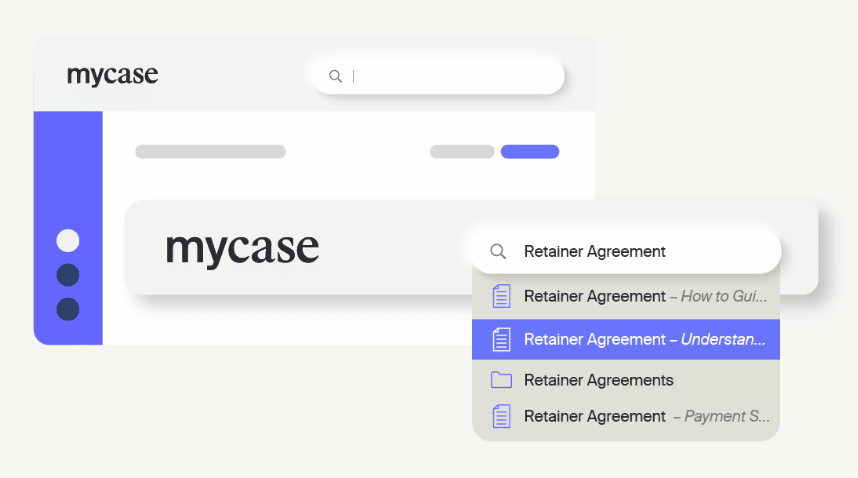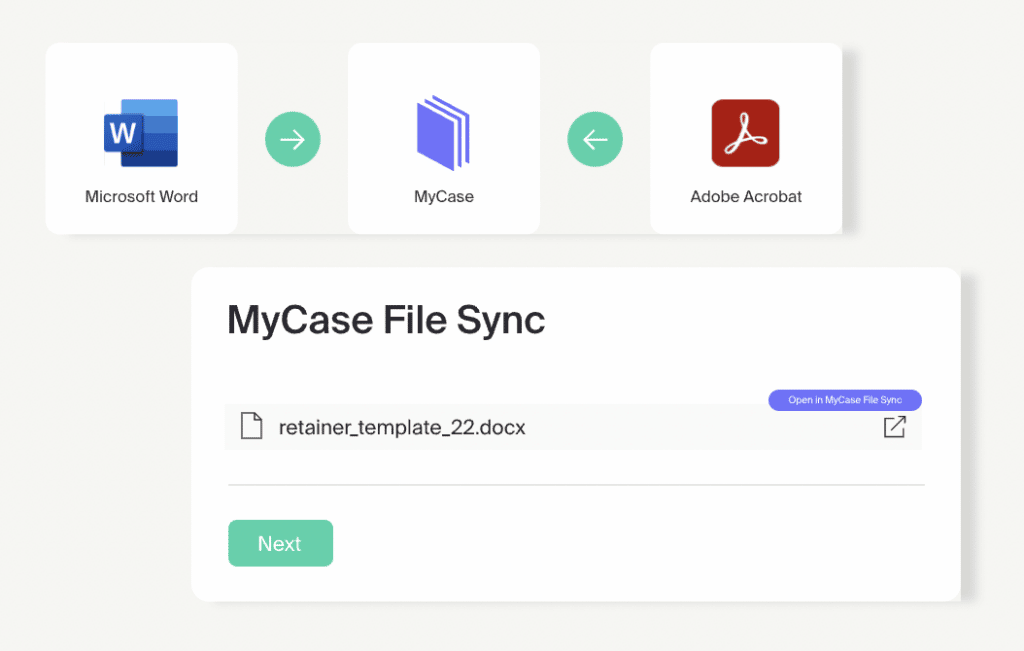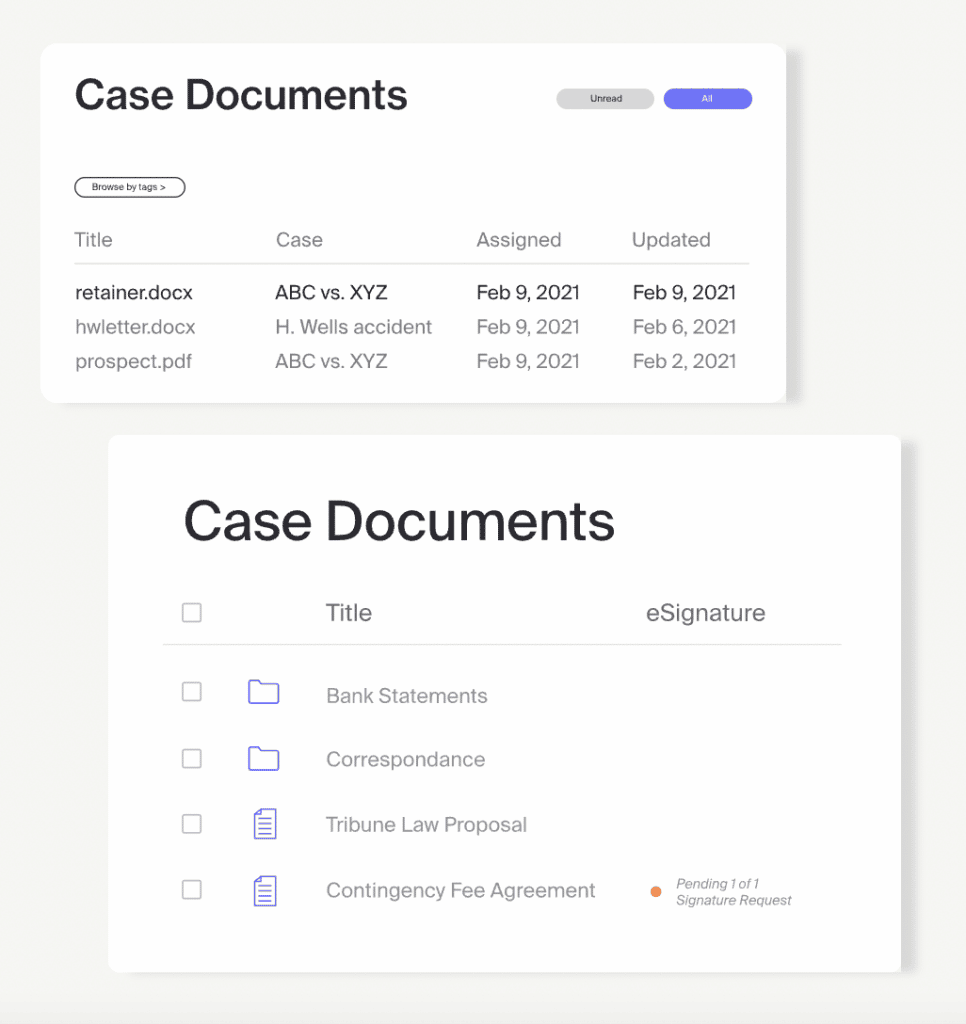Law Office Filing System: Examples & Advantages

A legal filing system is necessary not only for keeping all client casework organized, but also for maximizing efficiency, billable hours, and client satisfaction. Odds are, your firm could form a better organization system when it comes to document filing and access.
Here are a few questions to consider:
- Is your current law firm file organization system (and process) clear or messy?
- Is your process of sharing client and court files time-consuming?
- Overall, how easy is it to access the files that you need?
In this article, we’ll cover law firm filing system examples, why these systems are important for law firms, and why cloud-based legal filing is ideal.
What is a Law Office Filing System?

A document filing structure consists of three factors that determine where and how you store and access files.
1. Storage Space
First, determine if you have adequate storage space. If your firm uses physical documents for files, you may need to make room for additional filing furniture as your cases expand. Or if you’re at the point where your physical office space is at its maximum capacity, you’ll have to pay more money to move to a larger office or store archives off-site. A digital document filing system (or physical/digital hybrid) is an easy way to combat this issue since most (or all) files are stored in your computer and/or the cloud.
2. File Naming Conventions
A proper law firm file organization system consists of universal file naming conventions that all attorneys and staff members recognize and use. This can come in the form or combination of:
- Color-coded labels
- Practice type
- Motions or pleadings
- Client last name
- Lawyer name
However you develop your naming system, make it a part of your firm’s law firm operations and employee training. Standardization avoids clutter, as well as wasted time from trying to locate missing files.
3. Retention and Destruction Plans
Finally, well-organized filing systems encompass a file retention plan for trashing older files and keeping all digital and/or physical documents as tidy as possible. Check your local jurisdiction’s rules on how long each document (or file type) must be retained.
Why Are Effective Filing Systems Important for Law Firms?
The way in which you organize your documents affects productivity and cash flow (in the form of billable hours). If your legal filing is poorly organized, your attorneys will eat up time trying to locate specific documents.
In addition, paper-only models can slow things down since each needs to be (at worst) physically handed over or mailed, or (at best) scanned and emailed—which usually requires multiple follow-ups. This is a hassle for clients, stakeholders, and your law firm.
The most effective law office filing system examples consist of cloud-based storage and sharing. Your firm benefits by instantly and easily filing, locating, and sharing documents the exact moment they are needed. You can even incorporate secure eSignature functionality to receive signed documents in minutes. These systems save time and boost productivity.
Clients love it due to the convenience of receiving all case information instantly rather than having to wait for snail mail or physically drive to your firm’s office.
Why Should You Use a Cloud-Based Legal Filing System?
1. Remote Access to Files
With the rise of remote work, the most effective and competitive legal filing structures utilize cloud-based storage and sharing capabilities. With cloud-based filing, attorneys can easily find and share files from any desktop, laptop, or mobile device.
These systems are also becoming increasingly necessary to satisfy fully or hybrid remote work setups. According to a 2022 study from the American Bar Association (ABA), “87% of legal professionals reported that their workplace allows lawyers to work remotely.”
For more insight on how to build a successful remote work system, check out this article on how to thrive as a remote lawyer.
2. Client Satisfaction
The days of mailed documents and non-interactive emailed files are in the past. Clients expect modernized electronic filing systems for easy and convenient agreements, updates, and general communication (thank online shopping for this shift). And if your firm doesn’t modernize its file sharing, your competitors that utilize cloud-based systems will likely edge you out in the long run with happier clients and more referrals.
3. Time Saving
Your firm will spend more time on billable work by moving files to the cloud. Instead of sifting through file cabinets, you can instantly “search and find” the exact file you need.
Cloud-based file organization can also speed up client onboarding. For instance, if you’re in the process of taking on a new case, some cloud-based platforms (like MyCase) allow you to create digital client intake forms with e-signature capabilities. This streamlines the intake process while providing every potential client with the convenience of digital forms.
4. No More Lost Files
Digital filing systems also allow you to house, locate, annotate, approve, and share files from any device. No more lost files from clunky, physical cabinets. According to the MyCase 2021 Industry Report, “94% of legal professionals reported that document management software makes it somewhat or significantly easier to locate documents.”
Law Office Filing System Example
Utilizing a cloud-based filing system allows you to locate documents with ease. Using MyCase as an example, you can easily locate documents with Full Text Search.

When you’re ready to file, MyCase allows you to integrate existing documents from popular systems like Microsoft Word and Adobe Acrobat into the MyCase platform—so all documents live under one roof. From there, you can easily access, share, and annotate files with colleagues.

Furthermore, when you need access or an update on a specific document, you’ll know which file belongs to what case, when it was assigned, and the latest updates.

And when it’s time to onboard a new client, you can easily finalize initial paperwork by templatizing fee agreements and utilizing eSignature capabilities.

All in all, migrating to cloud-based filing systems can save time and money, while boosting team efficiency and client satisfaction.
For more specific law firm filing system examples, download our free guide on five document management software must-haves.
Start Your Legal Filing Today With MyCase
End the paper filing headache and choose the most effective cloud-based filing system: MyCase. With this practice management platform, you can perform the following tasks all under one roof:
- Document management
- Workflow automation
- Time tracking
- Billing and invoicing
- Client communication
- And more!
Try MyCase today risk-free with a 10-day free trial. We offer affordable monthly and yearly subscriptions. Plus, no commitment or credit card is required, and you can cancel anytime.
Also, subscribe to our “For The Record” email newsletter for more insightful articles on improving online workflows, increasing client intake, and more. Subscribe now by entering your email address in the right-hand sidebar near the top of the page.





